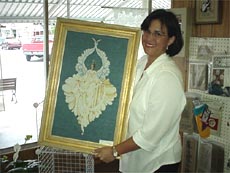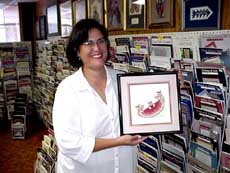|
The
new year started in disaster, but the hope that was carried into the
new millennium by its owners, longtime staff and customers brought
IGA through like a phoenix coming out of the fire. The store,
located at 713 Pulaski St., now glistens and sparkles with all new
fixtures, shiny floors, colorful walls and bright lights. The
upstairs offices have been remodeled. Even the parking lot has been
resurfaced, and additional outdoor lighting has been added. Bill
Campbell said, "Everything from the glue under the tiles to the
rubber roof is new.
"Because
of this we can honestly say that we have the newest equipment and
the freshest products in town," he said.

"There
are many new food items and the same friendly service that everyone
is used to getting from us. Everyone is a preferred customer. You
don’t have to have a card to benefit from our sales,"
Campbell continued.
Monday
will kick off a scheduled four-week grand opening. Gift certificates
worth $1,000 will be given away during the month, and prices on
selected items will be reduced to a 10-year low, according to
Campbell.
Following
the opening, IGA will have its annual auction. It will feature items
such as toys and household items that can be used as Christmas
gifts.

"The
most difficult thing about reopening is the long time frame in which
it took to reopen," Campbell said. "Being down so long was
hard."
Although
it was a strain, a couple of weeks after fire IGA restarted its free
delivery service for those customers who needed it. Campbell
explained that four or five employees were sent to the IGA in
Williamsville every Monday until it closed and then to the IGA in
Clinton to fill 30 orders each week. Deliveries were made to
customers on Tuesdays.
Many
of the full-time employees were kept on throughout the remodeling,
while others were rehired recently. In addition, 10 to 15 part-time
workers have been hired to restock and help run the store. Since
everything is new, there is a lot of training that needs to be done
on the new equipment, such as the cash register system.
The
grocers said the cost of the remodeling project was about $2 million. They estimated that the actual damage caused by the fire
was $1 million. "We started repairing one thing and it
kept growing from there," Campbell said.

"We
have 20 years’ worth of options on leasing this building, so we
plan on being here for some time," Campbell commented.
(To
top of second column)
|

The
bulk of the damage was caused by smoke. Soon after the fire, a Rock
Island salvage company came in and bought all of the inventory that
was canned or double sealed. The state mandates that all salvageable
items must be cleaned and dated before they can be sold to the
public at a resale shop. Campbell said, "We wanted to give this
food to the local food pantry, but state regulations are stringent
and we couldn’t take the risk."
The
layout of the store has remained the same to make things easier for
customers. The frozen food section has doubled, and every department
has expanded. The new equipment will help to make everything better,
according to Campbell. "Our service at the meat counter will
continue to be as good as it gets. It’s good stuff. We’re very
excited," he said.
Joy
Blair, IGA’s deli and bakery manager, has been employed with the
store since its inception. She feels that her corner of the store is
its prettiest section, with its self- serving hot case so that
customers can help themselves, expanded sandwich and salad case, and
freezer case for cakes and brownies. The deli is already booked for
two large catering events next week.
A
wheelchair with a basket has been added for customers’ use.
The
store’s fund-raising efforts will also be put into full swing.
Charlie Lee asks that any organization that had a cookout scheduled
or would like to have one call the store. The grocers estimate that
in the past 10 years they have helped not-for-profit groups raise
approximately $100,000. This doesn’t include the cost of repairing
the clock on top of Lincoln’s courthouse. "We’ve tried to
be as locally involved as we could be. We work and live in the
community with our families," Lee said, "We’re back and
ready to serve."

Leslie
Duncan, a longtime patron of IGA, is happy to see the store reopen.
She has missed its proximity to her home and its convenience. "IGA
is the only store that carries many of my favorite products,"
she says. She has also missed the friendly and personal atmosphere.
The
store hours are 6 a.m. to 10 p.m. seven days per week.
"Lincoln,
thank you for your patience. Sorry it took so long. We hope that
having the freshest products will make it worth the wait,"
Campbell concluded.
[Kym
C. Ammons-Scott]
|
|
Claire
Rawlins-Sniff’s love of needlework started early in life. Her
mother believed that all of her seven children, including the boys,
should know how to do everything. Claire learned to crochet when she
was 9, and as time went by, other skills like sewing, cross-stitch,
quilting and sewing were gleaned from her mother and grandmother.
Claire enjoyed the activity so much that her lifelong career goal
was to "do something that included sewing" or "be a
pastry chef." However, the realities of being a single mother
with college and braces to pay for put Rawlins-Sniff on the road
marketing to the financial services industry. She crisscrossed the
country for 15 years and admits that she always enjoyed her
Midwestern stops, especially Illinois, best.

When
Claire married David Sniff and settled in Lincoln two years ago, it
meant the opportunity to leave the fast pace behind and
"retire." Retirement didn’t last long. While shopping in
Sit ’n’ Knit a little over a year ago, Rawlins-Sniff made an
offhand offer to buy the shop to then-owner Linda Schneider, when
she was ready to sell. Schneider took her up on it. Claire reflects
that at the time, she was really joking, but the more she thought
about it, the more she wanted to do it.

Consequently,
Claire’s Needleworks opened its doors on Aug. 15, 1999. The store
had operated as Sit ’n’ Knit since the early ’80s, when opened
by Bonnie Welch. Linda Schneider owned the business for 13 years
prior to Claire’s purchase last year. Rawlins-Sniff felt it was
time for a name change to better describe the store’s current
inventory. That inventory has tripled in the last year. Almost 5,000
charts and patterns are now available. Accessories, notions and
specialty threads have been added as well. Yarn, an expensive
inventory to carry, is still available, as Claire likes to knit. She
notes that you can pick up a skein at a discount store for 88 cents
but it won’t be the long-lasting quality you’ll find at Claire’s.
(To
top of second column in this article)
|

In
the framing area, new designers have been added to give a wider
price spectrum. Rawlins-Sniff has been told by customers her regular
prices are up to 30 percent less than sale prices of big box stores.
Plus, turnaround time is shorter – usually seven to 10 days
instead of three to four weeks. Though customers are used to coming
to the store to have needlework framed, Claire’s can literally
frame anything. All work is done in the store, and Claire recently
completed a framer’s school in Chicago. Now she’s working on her
designation as a Certified Professional Framer, a process that will
take about 16 months. The framing business now comprises about 60
percent of the store’s income, greatly increasing since the
closing of Painter’s Art and Frames.

Of
all that Claire’s Needleworks has to offer, Rawlins-Sniff’s
favorite is the counted thread work in contemporary styles and
designs. Though there is still some inventory carry-over, she says
she hasn’t purchased anything for the store that she doesn’t
personally like, so the store is truly a reflection of her.
The
reflection extends to the Stitcher’s Group, which meets on
Tuesdays at 1 p.m. until everyone goes home. Anyone is welcome to
drop in and join in the fellowship. This was common in Hawaii, she
says, where handwork was an important element of socializing. When
visiting friends or relatives, you always took whatever you were
working on, and visited while keeping your hands busy. Another
element of Hawaiian handwork was the incorporation of nature,
usually represented in a solid color. Quilts in the Midwest are
heavily batted pieces of art, while in Hawaii there’s no need for
heavy batting, since it’s so warm.
Rawlins-Sniff
says she likes the concept of retail, and it – along with the
Stitcher’s Group – has given her the opportunity to meet many
new people and friends. After working so hard to take care of her
children, she feels richly blessed, and that the store is God’s
reward for a job well done. As Claire says, "What can be better
than coming to work to do what you love to do?"
[Wendy
Bell,
program manager for
Main Street Lincoln]
|

